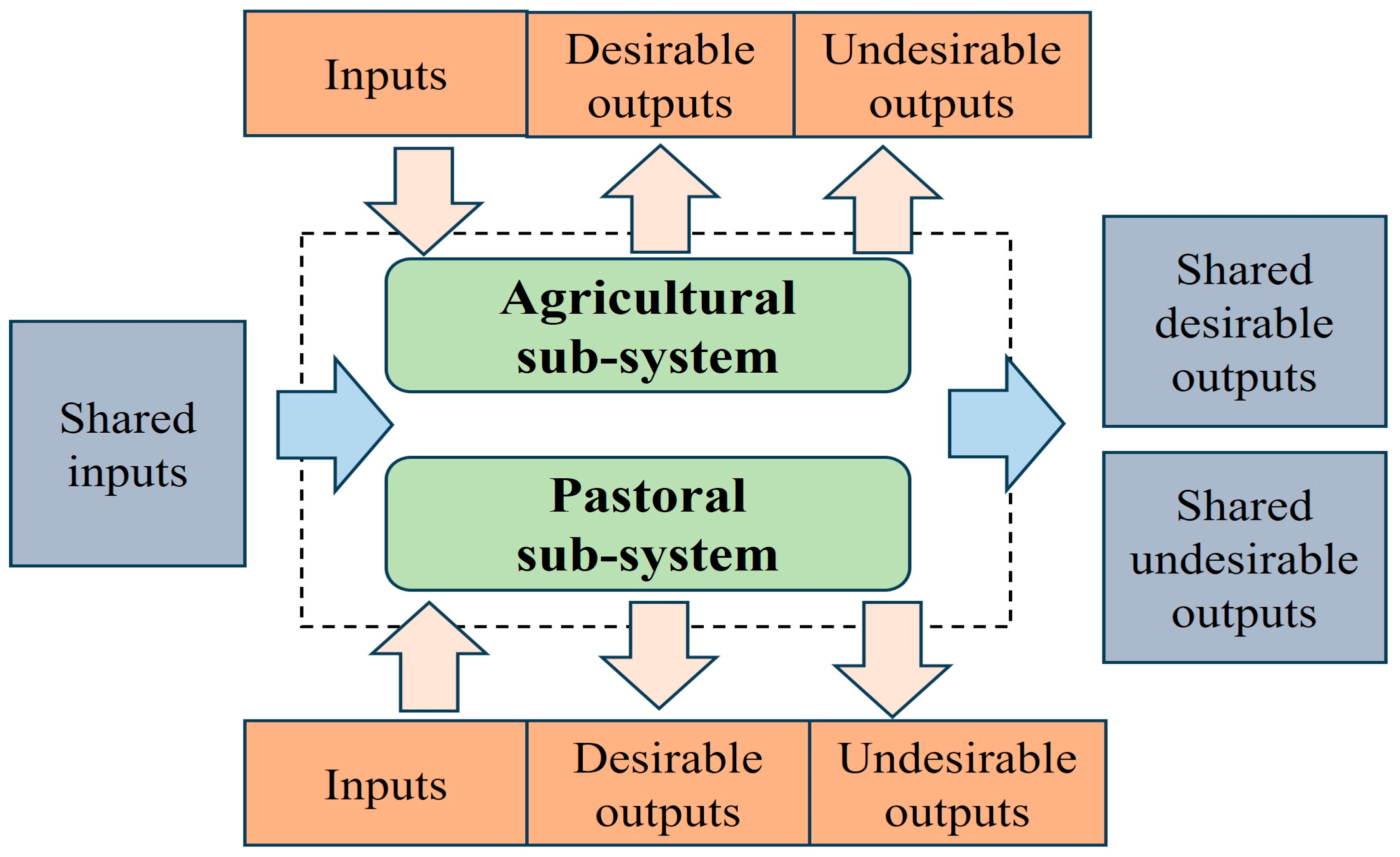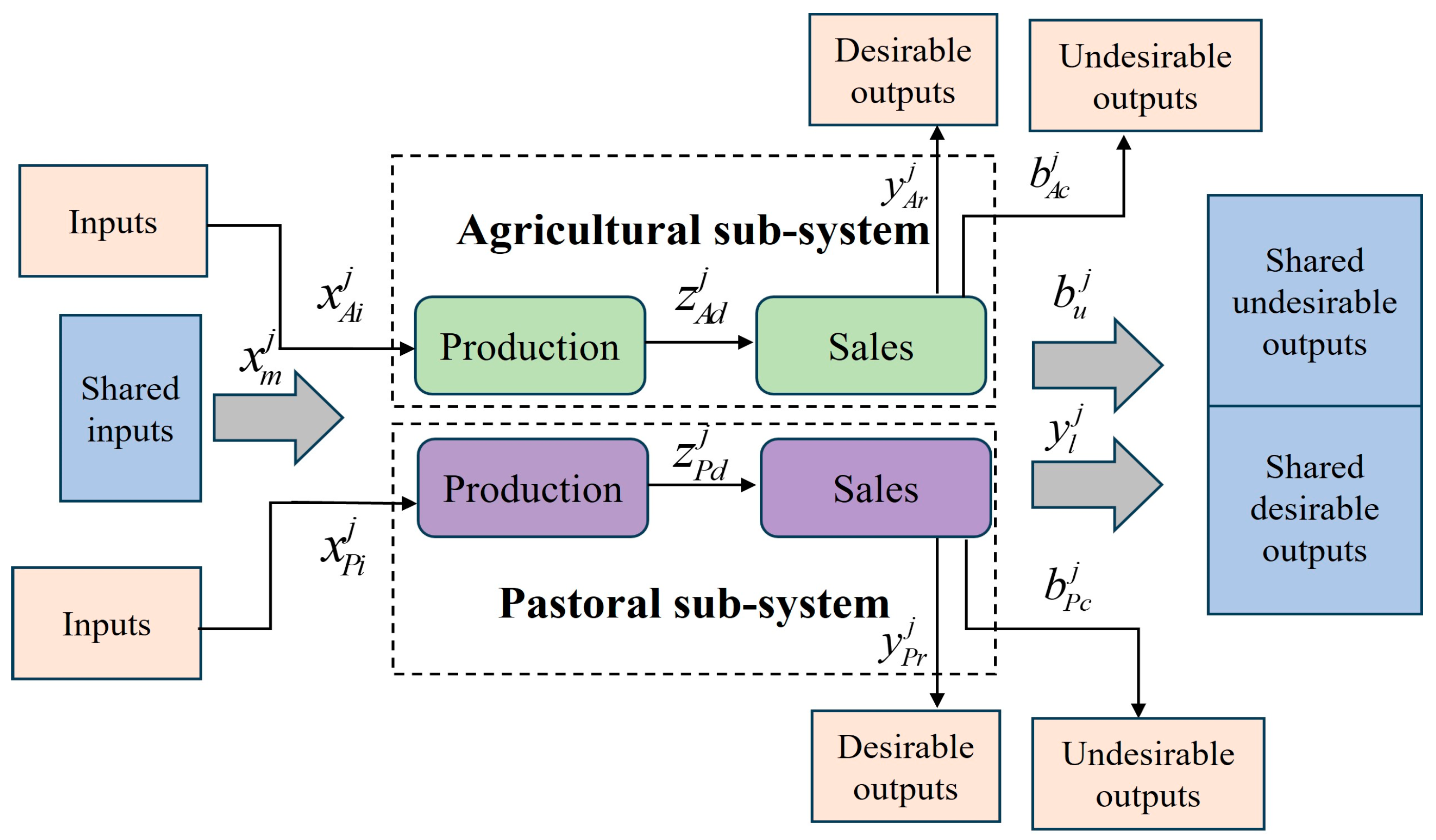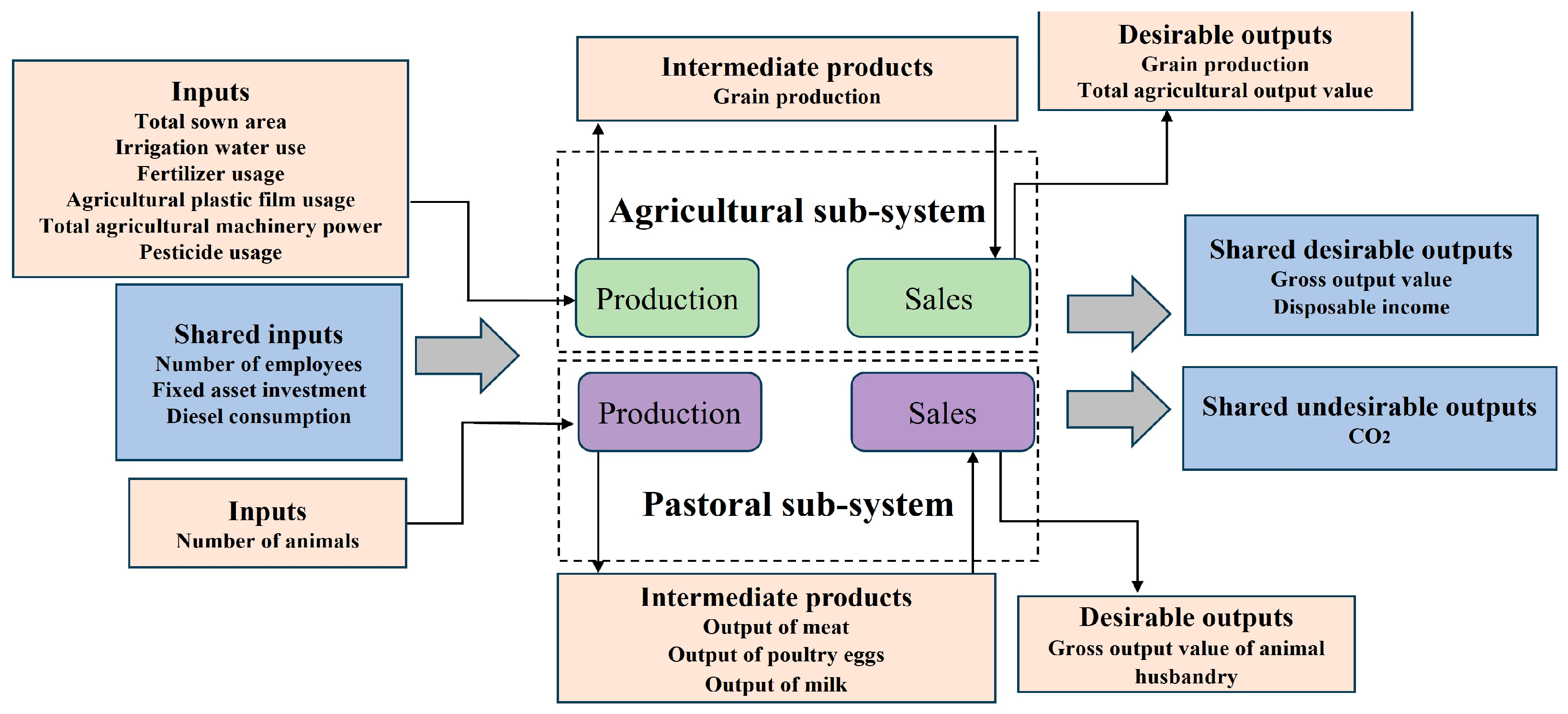To validate the proposed method, this section applies the new models to evaluate the efficiency of agricultural and pastoral systems in 30 provinces and cities in China.
4.1. Data
The existing literature selects different variables when evaluating the efficiency of agricultural and pastoral systems. For example, Zhang et al. [
36] selected the following variables: inputs (agricultural fertilizer applications, gross power of agricultural machinery, pesticides use, agricultural diesel use, crop sown area, and so on); outputs (added value of agriculture, forestry, animal husbandry, and fishing industry); and undesirable outputs (agricultural CO
2 emissions). Factors collected by Guo et al. [
37] include inputs (rural population, consumption of chemical fertilizers, consumption of pesticides, consumption of diesel fuel, and sown area of crops); outputs (gross output value of agriculture, forestry, animal husbandry and fishery and related indices, and per capita disposable income of rural households by region).
Based on existing research, this paper scientifically selects several factors.
Figure 3 illustrates the inputs and outputs in agricultural and pastoral systems. In the agricultural sub-systems, inputs include “Total sown area”, “Irrigation water use”, “Fertilizer usage”, “Agricultural plastic film usage”, “Total agricultural machinery power”, and “Pesticide usage”. The desirable output is “Total agricultural output value”. “Grain production” is the intermediate product. In the pastoral sub-systems, the input is “Number of animals”. Intermediate products include “Output of meat”, “Output of poultry eggs”, and “Output of milk”. The desirable output is “Gross output value of animal husbandry”. Shared inputs include “Number of employees”, “Fixed asset investment”, and “Diesel consumption”. Shared desirable outputs are “Gross output value” and “Disposable income”. The shared undesirable output is “CO
2”. The factors mentioned above are common inputs and outputs in agricultural and pastoral systems. Decision-makers utilize these inputs to generate certain outputs, while simultaneously producing CO
2 as a byproduct. The selected data are based on the agricultural and pastoral systems of 30 provinces and cities in China from the China Statistical Yearbook 2023.
Table 5,
Table 6 and
Table 7 show the summary of the relevant factors.
Scientifically determining the proportion of various stages and factors is crucial. This paper, based on interviews with experts, determines the distribution ratios for each stage and element. In our study, the production stage and the sales stage are equally important; thus, the following equation holds: . In China, the contribution of the agricultural system to Gross Domestic Product is higher than that of the pastoral system. Therefore, based on experts’ recommendations, this paper determines the proportion between the agricultural and pastoral systems to be as follows: , . Similarly, taking experts’ recommendations into account, more shared factors should be allocated to the agricultural sub-system compared to the pastoral sub-system. The proportions of “Number of employees”, “Fixed asset investment”, and “Diesel consumption” allocated to the agricultural sub-system are 0.65, 0.55, and 0.5, respectively. Their proportions allocated to the pastoral sub-system are 0.35, 0.45, and 0.5, respectively. The proportions of “Gross output value” and “Disposable income” allocated to the agricultural sub-system are 0.7 and 0.75, respectively, which means that the proportions allocated to the pastoral sub-system are 0.3 and 0.25. The proportion of CO2 allocated to the agricultural sub-system is 0.7, and the value allocated to the pastoral sub-system is 0.3.
4.2. Results
By applying Models (4), (8), and (12), we can obtain the evaluation results, which are reported in
Table 8. From an overall efficiency perspective, Beijing, Tianjin, Shanghai, Jiangsu, Henan, Sichuan, and Guizhou are efficient because the values of
,
,
,
,
, and
for them are all 1. The remaining DMUs are inefficient. Jilin’s performance is the poorest, with an efficiency score of only 0.6965, which indicates that its production process needs to be optimized. Ningxia’s efficiency value is 0.6969, ranking them second to last. It highlights that Ningxia’s production strategies need timely adjustments.
In terms of agricultural sub-system efficiency , Beijing, Tianjin, Shanghai, Jiangsu, Henan, Sichuan, and Guizhou are efficient with an efficiency score of 1. Jilin has the poorest performance with an efficiency score of 0.5888. This indicates that there are serious production issues within Jilin’s agricultural sub-system. The values of and for Jilin are 0.3352 and 0.8424, respectively, which are both relatively low compared to other DMUs. Shanxi’s efficiency is 0.5888. This indicates that there are issues within the agricultural sub-system as well. The values of and for Shanxi are 0.3753 and 0.8171, respectively, ranking towards the lower end. For Jilin and Shanxi, the inputs are substantial, but the outputs are relatively low among the 30 DMUs, especially considering that Shanxi’s total agricultural output value is only 1288.41. This indicates that they use a considerable amount of inputs to generate few outputs, which contributes to their lower efficiency. To improve the efficiency of the agricultural sub-system, based on our results, Jilin should reduce irrigation water use by 1286.75 (1000 Ha), fertilizer usage by 194.83 (10,000 t), agricultural plastic film usage by 3.61 (10,000 t), total agricultural machinery power by 3613.46 (10,000 KW), pesticide usage by 3.90 (10,000 t), CO2 emissions by 40.54 (10,000 tons), and diesel consumption by 26.07 (10,000 t), while increasing the total agricultural output value by 646.56 (CNY 100 M) and disposable income by 10,349.15 (CNY). Shanxi should reduce irrigation water use by 998.64 (1000 Ha), fertilizer usage by 79.98 (10,000 t), agricultural plastic film usage by 4.01 (10,000 t), total agricultural machinery power by 1103.34 (10,000 KW), pesticide usage by 1.91 (10,000 t), CO2 emissions by 41.63 (10,000 t), and diesel consumption by 9.18 (10,000 t), while increasing the total agricultural output value by 192.73 (CNY 100 M) and disposable income by 9340.17 (CNY).
From the perspective of pastoral sub-system efficiency , Beijing, Tianjin, Shanghai, Jiangsu, Zhejiang, Henan, Shandong, Sichuan, Guangdong, Guizhou, and Yunnan are efficient with an efficiency score of 1, which illustrates that they perform well. Xinjiang has the lowest efficiency at just 0.8217. From perspective of the production and sales stages, the values for and of Xinjiang are 0.7469 and 0.8966, respectively, which are significantly lower compared to other DMUs. Ningxia’s efficiency stands at 0.8283, ranking them second to last among the 30 DMUs. The values of and for Ningxia are 0.6707 and 0.9859, respectively, with ranking last. This indicates that there are significant issues in its pastoral system’s production stage. For Xinjiang and Ningxia, their pastoral sub-systems’ efficiency places them at a disadvantage compared to other DMUs. From the data perspective, Xinjiang’s pastoral sub-system has a substantial input (number of animals) value of 851.3, but the desirable output value (gross output value of animal husbandry) is only 1305.28, which is low compared to that of the other DMUs. This results in low efficiency. Ningxia’s pastoral sub-system also has high input but low output levels, which contribute to its relatively low efficiency as well. To improve the efficiency of the pastoral sub-system, Xinjiang could reduce CO2 emissions by 20.21 (10,000 t) and diesel consumption by 2.11 (10,000 t), while increasing the gross output value of animal husbandry by 717.81 (CNY 10,000) and disposable income by 474.48 (CNY). Ningxia could reduce CO2 emissions by 9.59 (10,000 t) and diesel consumption by 6.04 (10,000 t), while increasing disposable income by 712.00 (CNY).
Generally speaking, Beijing, Tianjin, Shanghai, Jiangsu, Henan, Sichuan, and Guizhou are efficient regardless of the overall system, agricultural sub-system, or pastoral sub-system. However, there are issues in the agricultural and pastoral systems of the other DMUs.
We also compare the average efficiency across different regions. The results are shown in
Table 9. From the perspective of overall efficiency, the average value in the Southwest region is the highest, at 0.9135. The Northeast region has the lowest average value, at only 0.7178. From the perspective of agricultural sub-system efficiency, the Southwest region has the highest average, while the Northeast region has the lowest average. In terms of pastoral sub-system efficiency, the Southwest region has the highest average, at 0.9849, while the Northwest region has the lowest, at only 0.8354. The above analysis indicates that the agro-pastoral development in the Southwest region is relatively good, with high production efficiency, ranking first among the seven regions. In contrast, the agro-pastoral development in the Northwest and Northeast regions is more underdeveloped, with low production efficiency, thus requiring timely adjustments in production strategies and the optimization of production processes to improve efficiency.











